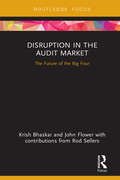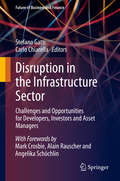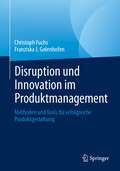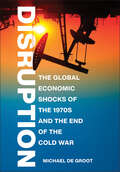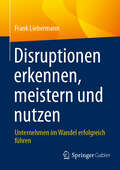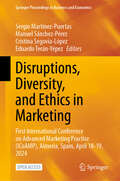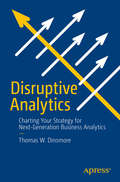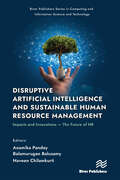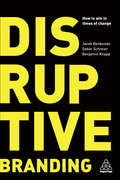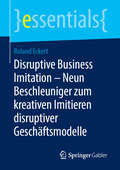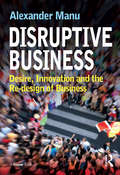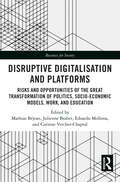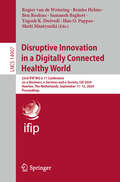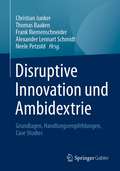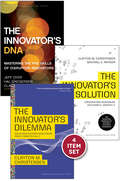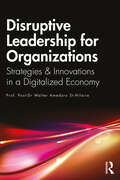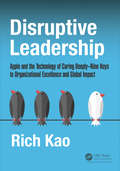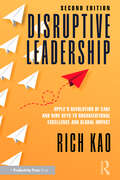- Table View
- List View
Disruption in the Audit Market: The Future of the Big Four (Disruptions in Financial Reporting and Auditing)
by John Flower Krish BhaskarFocussing on the dominance of the Big Four auditing firms – PwC, EY, Deloitte and KPMG – this concise volume provides an authoritative critical assessment of the state and future of the audit market, currently the subject of much debate and the focus of significant government enquiries. Drawing on extensive research and a vast collection of evidence from interviews with insiders, experts and users, it explores the key issues of audit quality, independence, choice and the growing expectation gap. Just as disruptive technologies are overturning other established sectors, this book explores their impact on accounting, financial reporting and auditing. It questions whether the Big Four-dominated audit market is prepared not only for the inevitable disruption of new technologies, but also the challenges of negative public perceptions, cynicism about regulation and demands for greater transparency. In the context of increasing high-profile corporate failures, this book provides a compelling scrutiny of the industry’s failings and present difficulties, and the impact of future disruption. At this crucial time, it will be of great interest to students, researchers and professionals in accounting and auditing, as well as policy makers and regulators.
Disruption in the Infrastructure Sector: Challenges and Opportunities for Developers, Investors and Asset Managers (Future of Business and Finance)
by Stefano Gatti Carlo ChiarellaA number of dramatic changes are currently reshaping infrastructure, a sector that investors and asset managers have traditionally considered to be a safe harbor in the field of alternative investments. Understanding the future of infrastructure is indispensable to guaranteeing a sustainable future for our planet and the welfare of the world’s population, and enhancing our knowledge of this asset class is one important step we can take toward reaching this crucial goal. This book collects a series of contributions by a group of Bocconi University researchers under the Antin IP Associate Professorship in Infrastructure Finance, which cover the key megatrends that are expected to reshape the way we think about infrastructure, and the implications for infrastructure investors and asset managers. Its goal is to improve and disseminate the culture of infrastructure among academics, professionals and policymakers. The main focus is on Europe and the European Union, and specifically on three key sectors: power and energy, transportation infrastructure, and telecoms / ICT.
Disruption und Innovation im Produktmanagement: Methoden und Tools für erfolgreiche Produktgestaltung
by Christoph Fuchs Franziska J. GolenhofenDieses Buch ist ein unverzichtbarer Leitfaden für jeden, der an der Konzeption und Entwicklung von Produkten beteiligt ist. Es beantwortet zwei grundlegende Fragen: Wie können Unternehmen einen Innovationsprozess und ein Umfeld gestalten, das für ein erfolgreiches Produktdesign förderlich ist? Und: Wie kann man ein Produkt retten, wenn das ursprüngliche Konzept die Markterwartung der Kunden nicht erfüllt?Die Autor*innen erläutern, wie Unternehmen Innovationsansätze und den Grundsatz „Form follows Function" in der Systemarchitektur vereinen. Sie zeigen Methoden wie Market Understanding, Design Thinking, Design to Value, Modularisierung und Agility auf, die in Zeiten von Disruption, Unsicherheit und Komplexität unentbehrlich geworden sind und in zahlreichen Branchen erprobt wurden. Mit vielen Erfahrungsberichten, Beispielen und Fallstudien sowie hilfreichen Tools zur praktischen Anwendung. "Auf der grundlegendsten Ebene bringt dieses Buch Ordnung ins Chaos. Es setzt unterschiedliche und hochrelevante Designansätze zu komplementären Lösungsansätzen für das Problem zusammen. Produktdesigner, Manager, Berater, Wissenschaftler und Studierende werden dieses wertvolle Buch sicher täglich zur Hand haben." Olivier L. de Weck, Ph.D. – MIT Professor für Luft- und Raumfahrttechnik und Engineering Systems, Chefredakteur Systems EngineeringDieses Buch stellt die Übersetzung einer englischsprachigen Originalausgabe dar. Die Übersetzung wurde mit Hilfe von künstlicher Intelligenz erstellt (maschinelle Übersetzung mit DeepL.com). Eine anschließende manuelle Überarbeitung erfolgte vor allem nach inhaltlichen Gesichtspunkten, so dass das Buch stilistisch von einer herkömmlichen Übersetzung abweicht.
Disruption: The Global Economic Shocks of the 1970s and the End of the Cold War
by Michael De GrootIn Disruption, Michael De Groot argues that the global economic upheaval of the 1970s was decisive in ending the Cold War. Both the West and the Soviet bloc struggled with the slowdown of economic growth; chaos in the international monetary system; inflation; shocks in the commodities markets; and the emergence of offshore financial markets. The superpowers had previously disseminated resources to their allies to enhance their own national security, but the disappearance of postwar conditions during the 1970s forced Washington and Moscow to choose between promoting their own economic interests and supporting their partners in Europe and Asia. De Groot shows that new unexpected macroeconomic imbalances in global capitalism sustained the West during the following decade. Rather than a creditor nation and net exporter, as it had been during the postwar period, the United States became a net importer of capital and goods during the 1980s that helped fund public spending, stimulated economic activity, and lubricated the private sector. The United States could now live beyond its means and continue waging the Cold War, and its allies benefited from access to the booming US market and the strengthened US military umbrella. As Disruption demonstrates, a new symbiotic economic architecture powered the West, but the Eastern European regimes increasingly became a burden to the Soviet Union. They were drowning in debt, and the Kremlin no longer had the resources to rescue them.
Disruption@WORK
by Fabiaan Van VrekhemWe are living in an age of accelerated change. The internet has washed away all limitations on time and space. Entrepreneurship has been democratized, and economies have globalized. Innovation has rendered entire sectors irrelevant in the blink of an eye. This is the reality any manager has to take into account in order to keep his company viable. Disruption@WORK taps into the roots of disruptive change, and offers a guide in recognising disruption, defining the ways in which it has already had an effect, and what awaits us in tomorrow's board rooms. In doing this, Disruption@WORK provides a view on the factors we have to deal with in bridging the gap between the individual, his work and corporate strategy, in order to face the future of our companies.
Disruptionen erkennen, meistern und nutzen: Unternehmen im Wandel erfolgreich führen
by Frank LiebermannDas Buch geht den Fragen nach, was Disruption ist, wie sie abläuft und welche technologischen und wirtschaftlichen Faktoren sie auslösen. Es untersucht, wie Unternehmen Disruptionen frühzeitig erkennen und bewältigen können. Dabei zeigt es die Phasen von den ersten Anzeichen bis zur Marktdominanz der Disruptoren auf. Besonderes Augenmerk wird auf die technologischen und wirtschaftlichen Treiber sowie auf die Strukturen gelegt, die dazu führen, dass Unternehmen zu langsam reagieren. Der fundierte Praxisteil beschreibt ein Framework, das anhand von Analysetools und Checklisten darlegt, wie sich Unternehmen auf Disruptionen vorbereiten können.
Disruptions, Diversity, and Ethics in Marketing: First International Conference on Advanced Marketing Practice (ICoAMP), Almeria, Spain, April 18-19, 2024 (Springer Proceedings in Business and Economics)
by Sergio Martínez-Puertas Manuel Sánchez-Pérez Cristina Segovia-López Eduardo Terán-YépezAs the marketing landscape continues to evolve, posing fresh challenges for both academics and practitioners, this book explores contemporary marketing issues, trends, challenges, and opportunities. Featuring papers presented at the first annual International Conference on Advanced Marketing Practice (ICOAMP) held in Almería, Spain in 2024, this open access book covers a broad range of topics focused analytics, measurements, and methodologies in marketing, health, medical and beauty decision-making; the impact of digital technologies on marketing management; marketing education; marketing oriented to operational data stores (ODS); non-profit marketing; marketing ethics (CSR) and social media, and digital marketing practices, among others. These topics are centered around three pivotal and interrelated themes: disruptions, diversity, and ethics, which are the cornerstones that drive our collective pursuit of understanding their impact on the world of marketing. It is imperative for modern businesses and marketers alike to grasp the intricacies of these factors and their implications. This book provides valuable contributions for marketing researchers and practitioners as well as managers of businesses in a wide range of industries
Disruptive Analytics
by Thomas W. DinsmoreLearn all you need to know about seven key innovations disrupting business analytics today. These innovations—the open source business model, cloud analytics, the Hadoop ecosystem, Spark and in-memory analytics, streaming analytics, Deep Learning, and self-service analytics—are radically changing how businesses use data for competitive advantage. Taken together, they are disrupting the business analytics value chain, creating new opportunities.Enterprises who seize the opportunity will thrive and prosper, while others struggle and decline: disrupt or be disrupted. Disruptive Business Analytics provides strategies to profit from disruption. It shows you how to organize for insight, build and provision an open source stack, how to practice lean data warehousing, and how to assimilate disruptive innovations into an organization.Through a short history of business analytics and a detailed survey of products and services, analytics authority Thomas W. Dinsmore provides a practical explanation of the most compelling innovations available today.What You'll LearnDiscover how the open source business model works and how to make it work for youSee how cloud computing completely changes the economics of analyticsHarness the power of Hadoop and its ecosystemFind out why Apache Spark is everywhereDiscover the potential of streaming and real-time analyticsLearn what Deep Learning can do and why it mattersSee how self-service analytics can change the way organizations do businessWho This Book Is ForCorporate actors at all levels of responsibility for analytics: analysts, CIOs, CTOs, strategic decision makers, managers, systems architects, technical marketers, product developers, IT personnel, and consultants.
Disruptive Artificial Intelligence and Sustainable Human Resource Management: Impacts and Innovations -The Future of HR (River Publishers Series in Computing and Information Science and Technology)
by Naveen Chilamkurti Balamurugan Balusamy Anamika PandeyIt is well-established that every organization is founded with a specific purpose and goals. Virtually all business organizations obtain measurements and metrics dealing with outcomes and results. However, what is reflected on the balance sheet does not necessarily show the actual worth of the organizations and ensure their survival and sustainability. Thus, the question arises, what exactly makes the organizations sustainable and thriving in an ever-changing environment? There are several examples of companies like Faber-Castell, Bank of Ireland, Chivas, DuPont and many more which have been able to sustain and survive over more than 200 years and still have a successful existence in the present era. Thus, it is important for the organization to pay equal attention to its three bottom lines, i.e., people, profit and planet for its sustainability, which not only meet the needs of the present generation but should have a futuristic approach as well. In the present era, organizations are adopting a new normal working dynamic and coping with the post-pandemic situations to sustain themselves in the business environment. Technology plays a significant role in this new working dynamic, and cutting-edge technologies like machine learning, artificial intelligence, blockchain,ChatGPT, Internet of Things, and much more effectively facilitate human functioning at work. The book aims to contribute to understanding and developing sustainable human resource management processes and practices aligned with recent technologies. It highlights the interconnection among the three bottom-line sustainable approaches for the growth and development of the organization. Topics discussed in this book include: • Disruptive Technologies and HR Sustainability • Convergence of Innovative Technologies, HR and Organizational Growth • Triple bottom-line Sustainability for HRM • Business-oriented Talent analytics and HR Sustainability • Role of Leadership in sustainable HRM practices.
Disruptive Branding: How to Win in Times of Change
by Jacob Benbunan Gabor Schreier Benjamin KnappDisruptive forces have rewritten the rules of business. In an age of continuous change the strength and authenticity of brands has become more important than ever. The organizations that can master their brand experience are able to survive disruption by disrupting themselves; companies that can't do this will leave themselves ripe for disruption. Disruptive Branding is a practical guide, demonstrating how to harness change to power your brand's survival and ensure growth in a transforming world. It will help ambitious, courageous and aspirational organizations to define their compelling brand strategies, design powerful brand experiences and innovate new brand-led products and services. Disruptive Branding tells the stories of businesses that have succeeded in managing the forces of disruption. From Nintendo fighting off its competition by re-imagining gaming, to Airbnb redefining what it means to travel, modern day brands are thinking faster and smarter than ever before. This book identifies the strategies and designs that some of the world's most successful brands use to stay one step ahead of the curve. It is an invaluable resource for brands working to withstand disruption - or even become disruptors themselves.
Disruptive Business Imitation – Neun Beschleuniger zum kreativen Imitieren disruptiver Geschäftsmodelle
by Roland EckertIm Hyperwettbewerb um Chancenanteile geht es scheinbar nur noch um disruptive Produkt- und Geschäftsmodellinnovationen. Beispiele zeigen jedoch, dass disruptive Imitatoren den disruptiven Innovatoren häufig wirtschaftlich den Rang ablaufen. Entgegen der allgemeinen Meinung scheint auch das kreative Imitieren disruptiver Geschäftsmodelle – das Disruptive Business Imitation Management – im Hyperwettbewerb zunehmend erfolgsrelevant zu werden. Auf diese Managementherausforderung der disruptiven Geschäftsmodellimitation fokussiert das vorliegende essential.Der AutorDr. Roland Eckert ist Professor an der FOM Hochschule für Oekonomie & Management in Essen/Düsseldorf. Er beschäftigt sich seit Jahren mit Fragen des multidimensionalen Innovationsmanagements und der erfolgskritischen Gestaltung intelligenter Echtzeitunternehmen im digitalen Hyperwettbewerb.
Disruptive Business: Desire, Innovation and the Re-design of Business
by Alexander ManuDisruptive Business is a provocative and insightful redefinition of innovation as an outcome of human behaviour, a dynamic in constant change requiring the shaping of new responses in business and the economy. Alexander Manu believes that organizations must treat innovation not as a process to be managed but as an outcome that changes people's lives. In Disruptive Business he explains how innovation is the moment when human behaviour is changed by a particular invention, discovery or event. This position challenges the current understanding of innovation, as well as the current ecology in which innovation operates in organizations: its management, methods, tools, language, focus and metrics. The challenge extends to some of the labels currently applied to innovation typologies, such as 'disruptive innovation', seen today as addressing purely the technological side of an invention, rather than the more complex motivational and behavioural side. Alexander Manu considers that a disruption is not manifest in the moment a new technology is introduced. The disruption is the human being and manifest only when human motivation embraces the technology and uses it to modify and improve everyday life. Our acceptance and appropriation of new technologies creates the business disruption. Manu makes the case that successful innovation outcomes are answers to conscious or subconscious goals residing in human motivation, and motivation starts in desire. This position is consistent with the history of innovations that have changed, improved and reshaped human life, and also consistent with their roots and ethos. Humans are a 'perpetually wanting animal', bound to desire, to seek media for a better self and to need innovation. In this dynamic, innovation is the constant and business is the variable. The role of business is to create the tools, objects and services through which people can manifest what they want and who they are. The book provides a new perspective of current behavioural disruptions which are relevant to the continuity of business, as well as a set of practical methodologies for business design, aimed at creating innovation outcomes of value to users.
Disruptive Digitalisation and Platforms: Risks and Opportunities of the Great Transformation of Politics, Socio-economic Models, Work, and Education (Business for Society)
by Mathias Béjean, Julienne Brabet, Edoardo Mollona, and Corinne Vercher-ChaptalThis book provides an overview of the opportunities and risks of digitalisation and the platforms that embody it and constitute society's new infrastructure. From a management point of view – defined here as the steering of organised and finalised collective action – understanding this major socio-technical disruption is paramount. The book helps to comprehend its main players, such as the American GAFAM, their power and its sources, their architecture, and their impact on different industries and professions, labour markets, companies, and education.Responding to the dominance of tech giants, numerous initiatives are striving to regulate their influence, safeguard democratic sovereignty, promote fair competition in the digital sphere, and employ frugal digitalisation methods to counteract detrimental aspects of these “oligopolistic” platforms. In essence, shouldn't the overarching aim of digitalisation be to foster community development, strengthen individual and collective capabilities, and preserve the environment, while producing goods and services to meet shared societal interests? Throughout the four sections of this book and its 16 chapters, actors in the digital process and/or academics provide analyses and illustrations of the great digital transformation, examining the ways in which socio-technical advances can be created or used for the benefit of all, while avoiding major risks.
Disruptive Diplomas: The Future of Education
by Clayton M. Christensen Scott D. Anthony Erik A. RothThis chapter looks at the field of education and posits that the same dynamics that prevail in other industries apply here as well. Signals of change abound, with low-cost/new-market education models springing up. Competitive battles are shaping up between established players and entrants with new capabilities, and incumbents must decide how to respond to disruption.
Disruptive IPOs? WR Hambrecht & Co.
by Clayton M. Christensen Tara DonovanBill Hambrecht faces a dilemma: should he accept a high profile client for his online Dutch auction IPO? Though it would be viewed as a real coup, what would accepting the business mean to WR Hambrecht? Should he seek other high profile clients like this, or should he try to work with those companies on lower profile financing activities like secondary offerings? Or perhaps he should work with companies that are too small to attract the attention of the big investment banks, who really don't like the whole Dutch auction idea. The case offers a very different setting to apply the theory of disruptive innovation, yet one in an industry that might be quite familiar to many students.
Disruptive IPOs? WR Hambrecht & Co.
by Clayton M. Christensen Tara DonovanBill Hambrecht faces a dilemma: should he accept a high profile client for his online Dutch auction IPO? Though it would be viewed as a real coup, what would accepting the business mean to WR Hambrecht? Should he seek other high profile clients like this, or should he try to work with those companies on lower profile financing activities like secondary offerings? Or perhaps he should work with companies that are too small to attract the attention of the big investment banks, who really don't like the whole Dutch auction idea. The case offers a very different setting to apply the theory of disruptive innovation, yet one in an industry that might be quite familiar to many students.
Disruptive Innovation in Chinese and Indian Businesses: The Strategic Implications for Local Entrepreneurs and Global Incumbents (Routledge Contemporary China Series)
by Peter Ping LiWith the rapid development of China and India as new economic powers in global competition, an obvious question is whether these emerging economies are great opportunities or threats. Whilst answers are bound to differ depending on one’s perspective, it is increasingly clear that more local firms, especially local entrepreneurs, from these emerging economies will play a more critical role in global competition by becoming challengers to global incumbents. Indeed, the fact that the majority of their populations are at the bottom of the pyramid, and thus cannot afford products designed for the developed markets, has made these emerging economies fertile ground for developing and applying disruptive innovations. A novel mix of key attributes distinctive from those of established technologies or business models, disruptive innovations are typically inferior, yet affordable and "good-enough" products or services, which originate in lower-end market segments, but later move up to compete with those provided by incumbent firms. This book sheds new light on disruptive innovations both from and for the bottom of the pyramid in China and India, from the point of view of local entrepreneurs and international firms seeking to operate their businesses there. It covers both the theoretical and practical implications of disruptive innovation using conceptual frameworks alongside detailed case studies, whilst also providing a comparison of conditions and strategic options in India and China. Further, unlike existing studies, this book focuses on the neglected perspective of local challengers as the primary players, and in doing so reveals the extent to which the future landscape of global competition may be shaped by disruptive innovation, as well as its capacity to make the world "flatter" and more sustainable. This unique book will be valuable to both scholars and practitioners interested in disruptive innovation and those working in the fields of Asian studies, international business, economics and globalization.
Disruptive Innovation in a Digitally Connected Healthy World: 23rd IFIP WG 6.11 Conference on e-Business, e-Services and e-Society, I3E 2024, Heerlen, The Netherlands, September 11–13, 2024, Proceedings (Lecture Notes in Computer Science #14907)
by Yogesh K. Dwivedi Matti Mäntymäki Remko Helms Ilias O. Pappas Rogier van de Wetering Ben Roelens Samaneh BagheriThis book constitutes the refereed proceedings of the 23rd IFIP WG 6.1 Conference on e-Business, e-Services and e-Society, I3E 2024, held in Heerlen, The Netherlands, during September 11–13, 2024. The 28 full papers and 8 short papers presented in this volume were carefully reviewed and selected from 77 submissions. They were organized in topical sections as follows: Artificial Intelligence Adoption and Impact; Digital Transformation and Organizational Innovation; Healthcare, Social Well-being, and Ethics.
Disruptive Innovation through Digital Transformation: Multi-Sided Platforms of E-Health in China
by Jie Zheng Xue Han Yuanyuan WuThe book addresses the prevalent digital transformation and focuses on its significant disruption in healthcare. In light of the distinctive characteristics and evolution of the Chinese healthcare industry, private multi-sided platform (MSP) companies emerge to offer novel values and explore the industry value chain. Drawing on the management and economics literature of MSPs, this book examines the selected Chinese MSPs and compares them with the counterpart MSPs in the U.S. This analysis highlights how the unfolding healthcare disruption is valuable for both scholars and practitioners to understand the trends and to take effective actions. “Disruptive Innovation through Digital Transformation: Multi-Sided Platforms of E-Health in China” provides readers in the developing and developed countries with insights on how to approach the current multi-sided platform and to resolve the current problems to better serve customers and patients in the healthcare market.
Disruptive Innovation und Ambidextrie: Grundlagen, Handlungsempfehlungen, Case Studies
by Thomas Baaken Christian Junker Frank Riemenschneider Alexander Lennart Schmidt Neele PetzoldDas Buch bietet neueste Erkenntnisse aus der Forschung der FH Münster zu disruptiven Innovationen und Geschäftsmodellen in Deutschland. Wie entstehen erfolgreiche Innovationen und Geschäftsmodelle, die Märkte radikal verändern und aus einem kleinen Initialfunken sehr schnell wachsen? Und auf der anderen Seite: Wie können sich bereits erfolgreiche Unternehmen im Zuge des disruptiven Wandels gut aufstellen? Wie funktioniert das Zusammenspiel großer, etablierter Unternehmen und junger Start-Ups auf diesem Feld? Diese und weitere Fragen hat die FH Münster in zwei aktuellen Studien untersucht, in denen zahlreiche disruptive und disruptierte Unternehmen untersucht wurden.
Disruptive Innovation: The Christensen Collection (The Innovator's Dilemma, The Innovator's Solution, The Innovator's DNA, and Harvard Business Review article "How Will You Measure Your Life?")
by Clayton M. Christensen Michael E. Raynor Jeff Dyer Hal GregersenClayton Christensen's definitive works on innovation-offered together for the first timeWill you fall victim to disruptive innovation-or become a disruptor yourself? Tip the odds in your favor with the bestselling books that have made Christensen one of the world's foremost authorities on innovation. You'll also get his award-winning HBR article, full of inspiration for finding meaning and happiness in your life using the principles of business.The 4-volume collection includes:The Innovator's Dilemma: When New Technologies Cause Great Firms to FailIn one of the most influential business books of our time, Christensen introduced the world to the concept of disruptive innovation, showing how even the most outstanding companies can do everything right-yet still lose market leadership. Don't repeat their mistakes.The Innovator's Solution: Creating and Sustaining Successful GrowthCiting in-depth research and theories tested in hundreds of companies across many industries, Christensen and co-author Michael Raynor provide the tools organizations need to become disruptors themselves.The Innovator's DNA: Mastering the Five Skills of Disruptive InnovatorsChristensen and coauthors Jeffrey Dyer and Hal Gregersen identify behaviors of the world's best innovators-from leaders at Amazon and Apple to those at Google, Skype, and the Virgin Group-to show how you and your team can unlock the code to generating and executing more innovative ideas."How Will You Measure Your Life?" (HBR article)At Harvard Business School, Clayton Christensen teaches aspiring MBAs how to apply management and innovation theories to build stronger companies. But he also believes that these models can help people lead better lives. In this award-winning Harvard Business Review article, he explains how, exploring questions everyone needs to ask: How can I be happy in my career? How can I be sure that my relationship with my family is an enduring source of happiness? And how can I live my life with integrity?
Disruptive Leadership for Organizations: Strategies & Innovations in a Digitalized Economy
by Walter Amedzro St-HilaireAimed as much at the neophyte as at the insider who questions why intellectual property rights (IPRs) matter in the digital age and the corporate strategies in the digitalised economy, this book approaches with perspicacity the development of disruptive mechanisms for organisations and IPR-centric leadership. The book is focused on organisations and a management systems perspective. The book identifies the technical practices and proposes multi-level strategies to promote disruptive leadership and encourage growth. The book then addresses the fundamentals of innovation and technology governance, from the production of ideas to the distribution of innovative products or services, including prototyping, financing, industrialisation and so on. It presents recent challenges, including open innovation, creativity and design thinking, and innovation of business models, placing them in the context of knowledge and the collaborative economy. The ambition of the book is to propose a framework for thought and action to the manager, which is composed of five walls – organisational creativity, intellectual property, financing, manufacturing and design of innovation – brought together under one roof, the business model of the technology. This device in which the manager must fit is situated in the strategy of his company and is to be embedded in a specific macroeconomic space.
Disruptive Leadership: Apple and the Technology of Caring Deeply--Nine Keys to Organizational Excellence and Global Impact
by Rich KaoDisruptive leadership is a topic generating intense interest. Companies all over the world are trying to upend their industry through innovative products and services. Becoming a disruptive organization, however, is easier said than done. Even more difficult is being a company that continually disrupts. Is it possible to discern a code for how companies can achieve this? In this highly readable and engaging book, a disruptive leadership framework is proposed in which caring deeply is placed at the center of the model. By turning care into a focal point, a triphasic model is proposed that moves from the personal sphere (individual), to the corporate arena (organizational), and then to the global stage (impact). Nine keys are identified along this path for how companies can realize organizational excellence. While care may seem like a soft concept in the rough and tumble world of business, it is argued how it is actually an inspired manner for providing direction, structure, and know-how that leads to powerful outcomes. Apple is profiled as a leading example of leveraging what is termed the technology of caring deeply. Other companies, such as Nike, IKEA, Zappos, Starbucks are also profiled. Finally, a leadership canvas is provided to help activate the lessons shared in the book.
Disruptive Leadership: Apple's Revolution of Care and Nine Keys to Organizational Excellence and Global Impact
by Rich KaoCompanies worldwide are striving to transform their industries through innovative products and services. Becoming a disruptive organization, however, is easier said than done. Even more difficult is being a company that continually disrupts. Is it possible to discern a code for how companies can achieve this? In this highly readable and engaging book, a disruptive leadership framework is proposed in which caring deeply is placed at the center of the model. Apple is used as the leading example. By turning care into a focal point, a triphasic model is proposed that moves from the personal sphere (individual), to the corporate arena (organizational), and then to the global stage (impact). Nine key factors are identified along this path for how companies can achieve organizational excellence.This second edition updates all the facts, data, and history around Apple since the first edition and calls out how its revolution of care continues to not only validate its success but astound with its seemingly unfettered upside. Its ability to disrupt seems to have no limits, thus challenging business leaders, present and future, to incorporate the DNA of care as they build and scale businesses. In addition to the previously profiled companies such as Nike, IKEA, 3M, and Starbucks, new case studies including Uniqlo, Alibaba, On Running, 7-Eleven, and Costco are presented to supplement Apple’s story.Features: A new organizational model is given for interpreting Apple's success. Nine principles of organizational excellence are discerned from this new model. Promotes caring deeply as a focal point for approaching disruptive leadership. New corporate profiles include Uniqlo, Alibaba, On Running, 7-Eleven, and Costco. Application questions and assignments are included for each chapter, making it an ideal training tool for leadership development and personal application.
Disruptive Marketing: What Growth Hackers, Data Punks, and Other Hybrid Thinkers Can Teach Us About Navigating the New Normal
by Geoffrey ColonNow that 75 percent of screen time is spent on connected devices, digital strategies have moved front and center of most marketing plans.But what if that's not enough? What if most people ignore company messages? What if consumer engagement never goes further than the "like" button? A sobering reality is hitting marketers. Technology hasn't just reshaped mass media, it's altering behavior as well. And getting through to customers will take some radical rethinking.First step is to toss the linear plan. Next is to strip away conventions, open your mind, and join Disruptive Marketing on a provocative, fast-paced tour of our changing world . . .Where selling is dead, but ongoing conversation thrivesWhere consumers generate the best content about brandsWhere people tune out noise and listen to feelingsWhere curiosity leads the marketing teamWhere growth depends on merging analytics with boundless creativityPacked with trends, predictions, interviews with big-think marketers, and stories from a career spent pushing boundaries, this book will propel you out of your comfort zone and into the disruptive mindset you need for future success.
